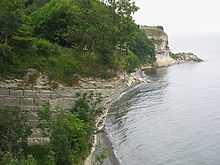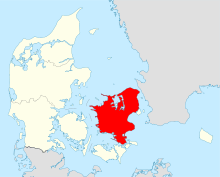Zealand
| Native name: Sjælland | |
|---|---|
 The Cliffs of Stevns south of Copenhagen | |
 | |
| Geography | |
| Location | Baltic Sea |
| Coordinates | 55°30′N 11°45′E / 55.500°N 11.750°ECoordinates: 55°30′N 11°45′E / 55.500°N 11.750°E |
| Area | 7,031 km2 (2,715 sq mi) |
| Country | |
| Region | Capital Region of Denmark, Region Zealand |
| Largest city | Copenhagen (pop. 1,181,239) |
| Demographics | |
| Population | 2,491,090 |
| Density | 354.3 /km2 (917.6 /sq mi) |
Zealand, also Seeland (Danish: Sjælland; pronounced [ˈɕɛˌlænˀ]) is the largest (7,031 km²) and most populated island in Denmark with a population just under 2.5 million representing about 45% of the country's total population.
It is the 96th-largest island in the world by area and the 35th most populous. It is connected to Funen by the Great Belt Bridge, to Lolland, Falster (and Germany from 2021)[1] by the Storstrøm Bridge and the Farø Bridges, and to Sweden over Amager and the Øresund Bridge.
Copenhagen, the capital of Denmark, is located partly on the eastern shore of Zealand and partly on Amager. Other cities on the island include Roskilde, Næstved and Elsinore.
Mythological origins
In Norse mythology as told in the story of Gylfaginning, the island was created by the goddess Gefjun after she tricked Gylfi, the king of Sweden. She removed a piece of land and transported it to Denmark, and it became Zealand. The vacant area was filled with water and became Mälaren.[2] However, since modern maps show a similarity between Zealand and the Swedish lake Vänern, it is sometimes identified as the hole left by Gefjun.
Geography
Zealand is the most populous Danish island (pop. 2012 est. 2,491,090).[3] It is joined to Funen by the Great Belt bridge and to Scania in Sweden by the Oresund bridge. It is irregularly shaped, and is north of the islands of Lolland, Falster, and Møn.
On June 5, 2007, the regional subsidiary of national broadcaster DR reported that Kobanke hill in the south east, near the town Rønnede in Faxe municipality, with a height of 122.9 m (403.21 feet), was the highest natural point on Zealand. Gyldenløveshøj, south of the city Roskilde, has a height of 126 m (413.4 feet), but that is due to a man-made hill from the 17th century and its highest natural point is only 121.3 m (397.96 feet).
Cities and towns
Urban areas with +10,000 inhabitants:
See also
- List of Danish islands
References
External links
| ||||||||||||||||||||||||||||||||
